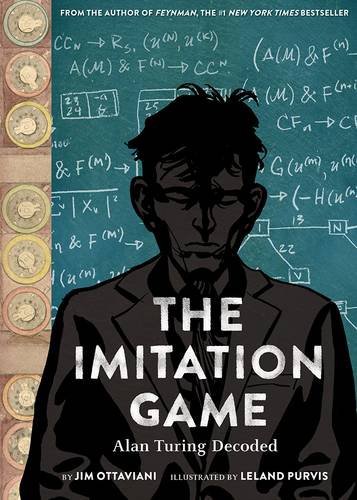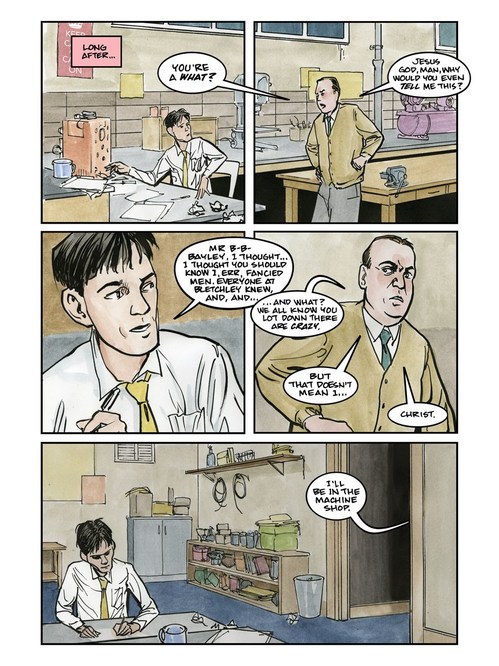The Imitation Game: Alan Turing Decoded by Jim Ottaviani & Leland Purvis
Comics Reviews Jim Ottaviani
Writer: Jim Ottaviani
Artist: Leland Purvis
Publisher: Abrams
Release Date: March 22, 2016
 Originally published on Tor.com, this biography of the brilliant, pioneering and tragically closeted computer scientist Alan Turing may share a title with the 2014 film that also covers Turing’s life, but neither is an adaptation of the other. The name of both comes from the test Turing developed to determine whether a machine has truly achieved artificial intelligence. Rather than the kind of dialogue portrayed in a film like Ex Machina, the test consists of a simultaneous, text-only interrogation of two parties by a third party, none of whom is in the same room. And one of the interrogated parties is a computer. If the person asking the questions cannot determine which of the interview subjects is a machine, artificial intelligence has been achieved.
Originally published on Tor.com, this biography of the brilliant, pioneering and tragically closeted computer scientist Alan Turing may share a title with the 2014 film that also covers Turing’s life, but neither is an adaptation of the other. The name of both comes from the test Turing developed to determine whether a machine has truly achieved artificial intelligence. Rather than the kind of dialogue portrayed in a film like Ex Machina, the test consists of a simultaneous, text-only interrogation of two parties by a third party, none of whom is in the same room. And one of the interrogated parties is a computer. If the person asking the questions cannot determine which of the interview subjects is a machine, artificial intelligence has been achieved.
Writer Jim Ottaviani has worked extensively in science labs (and has a master’s degree in nuclear engineering), which enables him to understand complex concepts and convey them accurately. But what makes this book worth reading is his grasp of how comics work, and what devices he can use from the medium’s sphere to communicate both facts and emotions.
Ottaviani has worked with a number of different artists, but the same intuitive storytelling runs through his books, suggesting that it comes from him more than from those who actually wield the Wacom (as Leland Purvis so ably does here). Ottaviani’s biography of Richard Feynman bounced ideas around like atoms colliding inside a nuclear bomb. His wonderful book about the “Trimates” Jane Goodall, Dian Fossey and Birute Galdikas braided three distinct stories, each represented by its own visual style, into one narrative. The Imitation Game does something similar with Turing, portraying his ceaseless motion (intellectual and physical—he ran marathons and cycled long distances) in panels that often show him halfway out of the frame already. He appears in profile frequently, usually headed from left to right, into the future as it were, and his body angles in that direction, seeming even more hurried than it is.

The Imitation Game: Alan Turing Decoded interior art by Leland Purvis
Third parties, witnesses to various aspects of this life, provide their own insight in ghostlike, grayed-out panels, their words represented in pink text boxes when they’re not on camera. Turing’s own narration is in yellow boxes to set it apart. No omniscient voice informs the reader, so we have to judge for ourselves. The connection between this artistic decision and Turing’s own work on artificial intelligence is made clear when the book delves into the titular test.
The answers given by party A and party B in the test are represented in the same pink boxes as the words of those who knew Turing. In other words, Ottaviani is subtly making Turing’s point: artificial intelligence can’t be perceived from the inside. If we trust that the humans around us are making the same mental connections we are—because we can’t see inside their heads—then we have to extend that same kind of courtesy to machines, based on empirical evidence. It’s a sharp way to construct what could otherwise be just another biography of a scientist, and it demonstrates what nonfiction comics can do when they’re not just laying one fact after another.

The Imitation Game: Alan Turing Decoded interior art by Leland Purvis